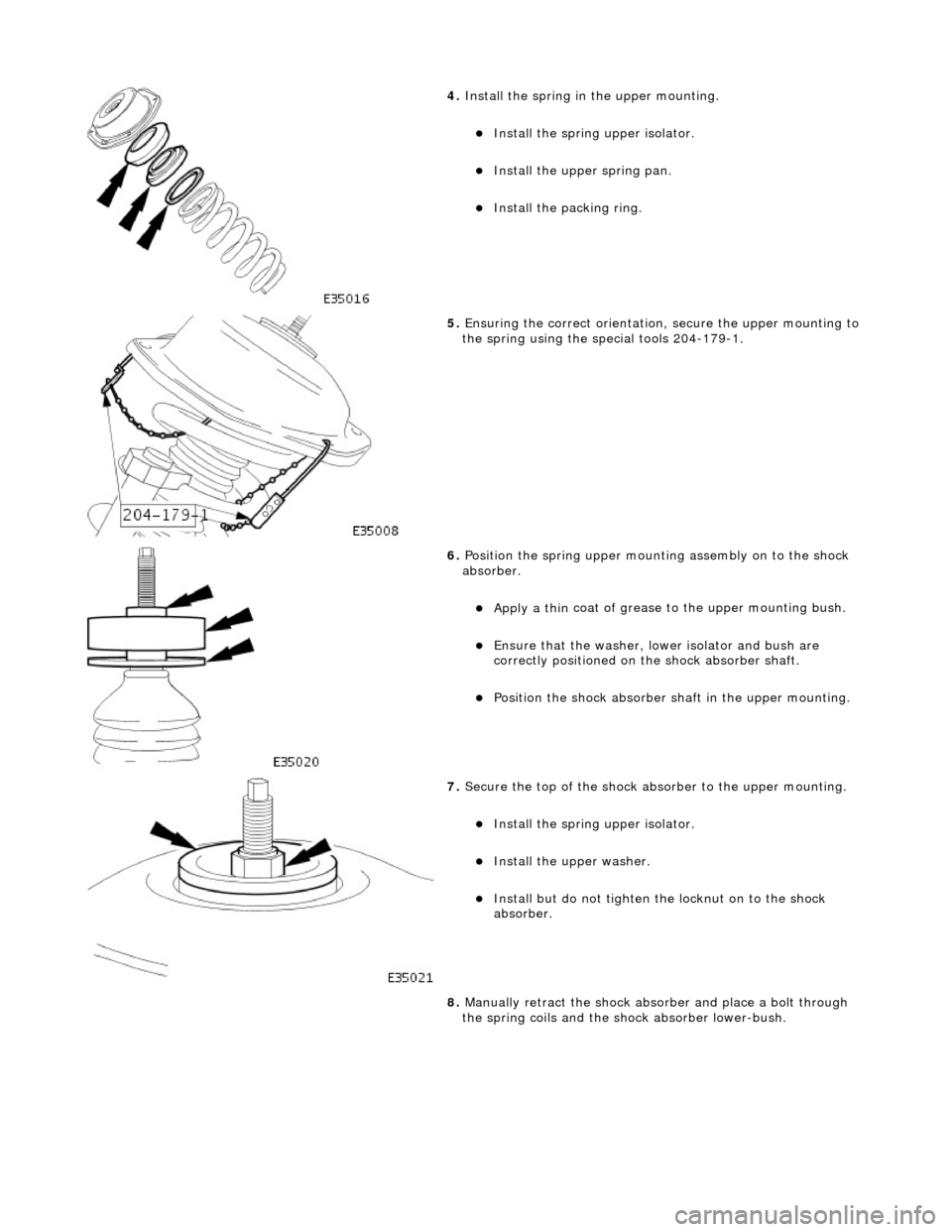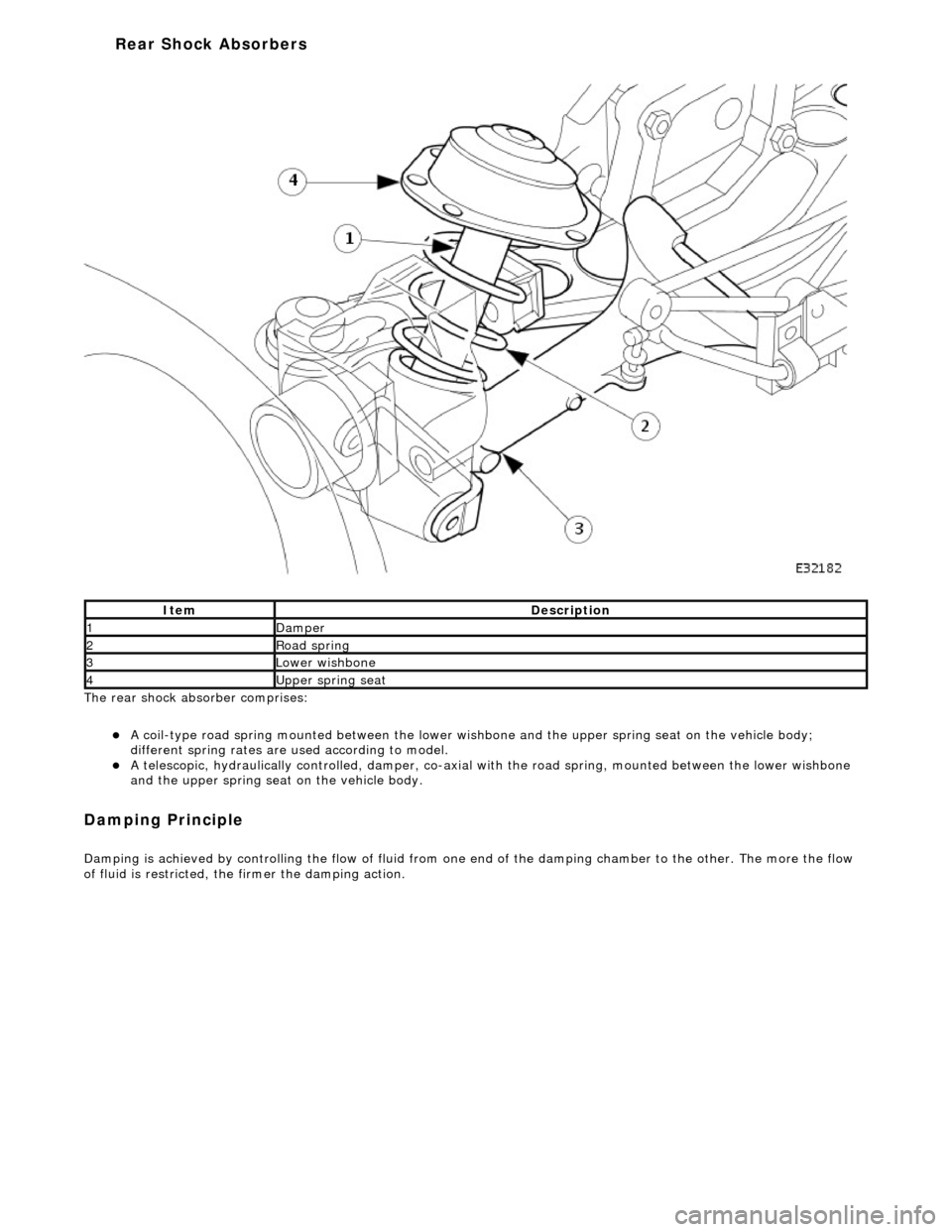Oil JAGUAR X308 1998 2.G Owner's Manual
[x] Cancel search | Manufacturer: JAGUAR, Model Year: 1998, Model line: X308, Model: JAGUAR X308 1998 2.GPages: 2490, PDF Size: 69.81 MB
Page 199 of 2490

18
.
Lower and remove the jack.
19. Remove the shock absorber an d spring assembly from the
vehicle and place the assembly on a work bench.
20. Clean the upper mounting spring location.
21
.
Remove the pigtail seat and cl ean the wishbone lower spring
location.
22
.
With assistance, manually compress the shock absorber and
withdraw the bolt from the spring coils.
23
.
Remove the shock absorber from the upper mounting.
пЃ¬Posi
tion a wrench on the shock absorber shaft flats to
prevent rotation (wrench in socket on vehicles with
adaptive damping).
пЃ¬R
emove the shock absorber
upper retaining nut.
пЃ¬Remove the
upper washer and isolator.
24. Remove the special tools 204-179-1 and remove the upper
mounting from the spring.
Page 202 of 2490

4. Install the spri
ng in
the upper mounting.
пЃ¬Install the spri
ng upper isolator.
пЃ¬Install
the up
per spring pan.
пЃ¬Inst
al
l the packing ring.
5. Ensuri ng the correct orientati
on,
secure the upper mounting to
the spring using the special tools 204-179-1.
6. Position the spri ng
upper mounting assembly on to the shock
absorber.
пЃ¬Apply a th in
coat of grease to the upper mounting bush.
пЃ¬E
n
sure that the washer, lo
wer isolator and bush are
correctly positioned on the shock absorber shaft.
пЃ¬Po si
tion the shock absorber shaft in the upper mounting.
7. Sec
ure the top of the shock ab
sorber to the upper mounting.
пЃ¬Install the spri
ng upper isolator.
пЃ¬Inst
al
l the upper washer.
пЃ¬In
s
tall but do not tighten the locknut on to the shock
absorber.
8. Manually retract the shock abso rber and place a bolt through
the spring coils and the sh ock absorber lower-bush.
Page 271 of 2490

Vehicle Dynamic Suspension - Vehicle Dynamic Suspension
Description an
d Operation
Front Sho
ck Absorbers
The front shock absorber
comprises:
пЃ¬A
coil-type road spring, mounted between the lower wish
bone spring pan and the front suspension crossbeam;
different spring rates are used according to model.
пЃ¬A
telescopic, hydraulically controlled, damper mounte
d between the lower wishbone and the vehicle body.
It
em
De
scription
1Front
suspension crossbeam
2Front
hub assembly
3Ro
ad spring
4Dam
per
Page 272 of 2490

The rear shock ab
sorber comprises:
пЃ¬A
c
oil-type road spring mounted between the lower wish
bone and the upper spring seat on the vehicle body;
different spring rates are used according to model.
пЃ¬A te
lescopic, hydraulically controlled, damper, co-axial wi
th the road spring, mounted between the lower wishbone
and the upper spring seat on the vehicle body.
Damp
ing Principle
D
a
mping is achieved by controlling the flow of fluid from one
end of the damping chamber to the other. The more the flow
of fluid is restricted, the firmer the damping action.
Ite
m
De
scr
iption
1Dam
p
er
2Ro
ad s
pring
3Lower wishbon
e
4Upper sprin
g seat
Rear Shock A
b
sorbers
Page 273 of 2490

The
Nivomat ride levelling system improves ride quality by al
lowing the use of softer road springs, while controlling the
effects on the suspension of a fully laden vehicle. The system uses special rear dampers in place of the normal units. There
are no other components in th e system. The ride levelling system is comple tely automatic, requiring no input from the
driver.
Ride levelling may be specified as an opti on on certain models; it is not available in north American markets. Ride levelling
and adaptive damping are mu tually exclusive options.
The Nivomat damper:
пЃ¬Su
pplements the load-carrying capacity of th
e road springs at high vehicle loads.
пЃ¬Uses road inputs to the
suspension to power the levelling function.
пЃ¬De
tects suspension height dire
ctly from road wheel travel.
пЃ¬Provi
des load-dependent spring rates; the ac
cumulator gas pressure increases with load.
пЃ¬Pr
ovides load-dependent damping; the fluid pressure increases with load.
Op
eration
F
ollowing an increase in vehicle loading,
the dampers adapt to maintain the height of the vehicle within its design range.
The system uses road inputs to the suspension to power the levelling action, and requires up to approximately two
kilometers of travel, following a change in load, to complete the process.
Normal movement of the suspension caus es a pumping action to occur within the damper, as a result of extension and
compression of the pump rod in the pump chamber. Hydraulic fluid is pumped from the pump cham ber into a high pressure
gas accumulator. The increase in gas pressure augments the force developed between th e vehicle axle and the body,
thereby providing lift.
It
em
De
scription
1Pi
ston rod
2Pum
p chamber
3High
pressure
gas accumulator
4Diaphragm
5Co
ntrol orifice
6Pump rod
7Low pressure gas ch
amber
8Low pressure oil
reservoir
Ride Levelling
Page 274 of 2490

A c
ontrol orifice in the pump rod determines the levelling height. When the damper is compressed, this orifice is covered.
When the damper extends, the control orif ice is uncovered, pressure is released to the low pressure oil reservoir and the
system ceases to rise. When the vehicle is high after unloading, the opened control or ifice allows fluid to be returned to the
low pressure oil reservoir, and the suspensi on returns to its normal unladen height.
Ad
aptive Damping
•
NOTE: Items 2 and 5 are ALWAYS located
on the passenger side of the vehicle
Adaptive damping enhances vehicle handli ng by the use of special dampers which are controlled by a dedicated control
module.
Adaptive damping may be specified as an option on certai n models. Adaptive damping and ride levelling are mutually
exclusive options. The adaptive damping system is completely automatic, requiring no input from the driver.
A d
aptive Dampers
The adaptiv
e dampers:
пЃ¬Are inst
alled in place of the normal dampers.
пЃ¬Can be identified
by the cable and connector at the top of the unit.
пЃ¬Have two settings; fi
rm and so
ft.
It
e
m
De
scr
iption
1Dam
p
er, front right-hand
2Accel
e
rometer, lateral
3Accel
e
rometer,
front vertical
4D
a
mper, rear right-hand
5Adaptive dampin
g control module (A
DCM)
6Accel
e
rometer, rear vertical
7D
amper, rear l
eft-hand
8Dam
p
er, front left-hand
Page 285 of 2490

R
ear Drive Axle/Differential - Rear Drive Axle and Differential
Description an
d Operation
Loca
tion
The differential
unit
is mounted between the wide mount ing bracket, pendulum assembly and the wishbone tie assembly.
Two tie rods are fitted between top rear of the final dr ive casing and the front of the wide mounting bracket.
Parts List
Description
The
type 14 HU final drive assembly is a hypoid unit with th
e pinion arranged on the cross-car centerline. The driveshaft
coupling utilizes a cassette type pinion oil seal, which is an in tegral part of the pinion flange. This type of seal cannot be
separated from the pinion fl ange and therefore may only be renewed as a complete seal / flange assembly
The axle shafts are driven by the output flanges which rotate on sealed bearings , these assemblies being retained in the
final drive unit by circlips.
Pinion Drive Flange / Seal Detail
• NOTE: The component parts are shown in an exploded view for clarity, this is NOT the fitted condition
It
em
Par
t Number
De
scription
1—F
inal Drive Unit
2—W
ide Mounting Bracket
3—Pen
dulum Assembly
4—Wi
shbone Tie Assembly
5—'A'
Frame
Page 290 of 2490

In
stallation
(and axle shaft if i
t
is to be re-used)
1. Installation is the re verse of the removal procedure, noting the
following.
2. Secure the axle shaft.
1.
Apply thread locking agent, to the SPLINE, as
indicated.
2. Refer to the illustration - do NOT re-use the original
nut.
3. Re
fer to the illustration.
4. Re
fer to the illustration.
пЃ¬E
n
sure that the match marks ar
e aligned prior to securing
the fixing.
5. Check and adjust as required, the final drive unit oil level.
6. Check and adjust as required, the rear wheel alignment, 204-
02.
Page 294 of 2490

6.
CAUTIO
N: If the gap CANNOT be achieved,
contact Jaguar Service
2. A gap smaller than specified will indicate an improperly fitted circlip. This may be rectified by
refitting or by the application of radial pressure
around the inner circum ference of the circlip
7. Verify t
hat the output shaft end-float is within specification
8. Re
fer to the illustration
пЃ¬If
app
ropriate realign the pr
eviously made match marks
9. Check the final drive oil level and adjust as required
10. Check and adjust rear wheel camber setting
Page 299 of 2490

11
.
Correct the final drive oil level as required.
12. Adjust the parking brak e cable as required.